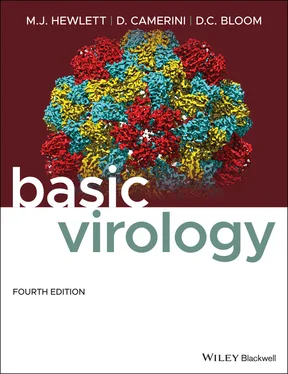Source: Courtesy of S. Larson and A. McPherson, University of California, Irvine.
(c) The structure of the RNA genome inside the capsid as determined by x‐ray crystallography.
The shape of a given type of virus is determined by the shape of the virus capsid and really does not depend on whether or not the virus is enveloped. This is because for most viruses, the lipid envelope is amorphousand deforms readily upon preparation for visualization using the electron microscope.
As we have noted, since it is not clear that all viruses have a common origin, a true Linnaean classification is not possible, but a logical classification is invaluable for understanding the detailed properties of individual viruses and how to generalize them. Schemes dependent on basic properties of the virus, as well as specific features of their replication cycle, afford a useful set of parameters for keeping track of the many different types of viruses. A good strategy for remembering the basics of virus classification is to keep track of the following:
1 What kind of genome is in the capsid: Is it DNA or RNA? Is it single stranded or double stranded? Is the genome circular or linear, composed of a single piece or segmented?
2 How is the protein arranged around the nucleic acid; that is, what are the symmetry and dimensions of the viral capsid?
3 Are there other components of the virion?Is there an envelope?Are there enzymes in the virion required for initiation of infection or maturation of the virion?
Note that this very basic scheme does not ask what type of cell the virus infects. There are clear similarities between some viruses whether they infect plants, animals, or bacteria. Despite this, however, it is clear that basic molecular processes are somewhat different between the Archaea, Eubacteria, and Eukaryota kingdoms; further, among eukaryotes, it is increasingly clear that there are significant differences in detail between certain processes in plants and animals. For this reason, viruses infecting different members of these kingdoms must make different accommodations to the molecular genetic environment in which they replicate. Thus, the nature of the host is an important criterion in a complete classification scheme.
Note also that there is no consideration of the disease caused by a virus in the classification strategy. Related viruses can cause very different diseases. For example, poliovirus and hepatitis A virus are clearly related, yet the diseases caused are quite different. Another more extreme example is a virus with structural and molecular similarities to rabies virus that infects Drosophila and causes sensitivity to carbon dioxide!
The Baltimore scheme of virus classification
Knowledge of the particulars of a virus's structure and the basic features of its replication can be used in a number of ways to build a general classification of viruses. In 1971, David Baltimore suggested a scheme for virus classification based on the way in which a virus produces messenger RNA (mRNA) during infection. The logic of this consideration is that in order to replicate, all viruses must express mRNA for translation into protein, but how they do this is determined by the type of genome utilized by the virus. In this system, viruses with RNA genomes whose genome is the same sense as mRNA are called positive‐sense (+ sense) RNA viruses, while viruses whose genome is the opposite ( complementary) sense of mRNA are called negative‐sense (− sense) RNA viruses. Viruses with double‐stranded genomes obviously have both senses of the nucleic acid.
The Baltimore classification has been used to varying degrees as a way of classifying viruses and is currently used mainly with reference to the RNA genome viruses, where positive‐ and negative‐sense viruses are grouped together in discussions of their gene expression features. This classification scheme is not complete, however. Retroviruses, which are positive sense but utilize DNA in their replication cycle, are not specifically classified. Still, the scheme provides a fundamental means of grouping a large number of viruses into a manageable classification.
A more general classification based on a combination of the Baltimore scheme and the three basic criteria listed above is shown in Table 5.2. When compared to the listing of viruses in Table 5.1, it is clear that this scheme is not complete; for example, viruses with complex morphology are not well represented. More importantly, subtle distinctions such as the actual genetic relatedness of the proteins involved in viral genome replication are not taken into account. Indeed, only those viruses that have been characterized in some detail, and whose infection has some medical or economic impact upon humans, have been included; if a virus is not a human pathogen or if its occurrence has no obvious economic impact, it has been ignored. While the scheme can be expanded to include all known viruses, it then loses the value of relative simplicity.
Disease‐based classification schemes for viruses
While molecular principles of classification are of obvious importance to molecular biologists and molecular epidemiologists, other schemes have a significant amount of value to medical and public health professionals. The importance of insects in the spread of many viral diseases has led to many viruses being classified as arthropod‐borne viruses, or arboviruses. Interestingly, many of these viruses have general or specific similarities, although many arthropod‐borne viruses are not part of this classification. The relationships between two groups of RNA viruses that are classified as arboviruses are described in some detail in Part IV, Chapter 13.
Viruses can also be classified by the nature of the diseases they cause, and a number of closely or distantly related viruses can cause diseases with similar features. For example, two herpesviruses, Epstein–Barr virus (EBV) and human cytomegalovirus (HCMV), cause infectious mononucleosis, and the exact cause of a given clinical case cannot be fully determined without virological tests. Of course, completely unrelated viruses can cause similar diseases too. Still, disease‐based classification systems are of value in choosing potential candidates for the etiologyof a disease. A general grouping of some viruses by similarities of the diseases caused or organ systems infected was presented in Table 3.1.
The ICTV published their tenth report in 2017. This report is available online ( https://talk.ictvonline.org/ictv‐reports/ictv_online_report), and the current (2019) Master Species List database of viruses can be downloaded at the ICTV website ( http://ictvonline.org). The current database contains 4958 different virus species arranged in 846 genera, 143 families, and 14 orders. They are listed by virus families in Table 5.1. While this is a notable achievement, it is not a complete one – the pace of discovery of new viruses and characterization of the genes they encode ensures that the number will change. Further, it is increasingly evident that the very nature of virus replication and association with their hosts leads to complications not found in classification schemes for cell‐based life. The rate of genetic change in viruses can be great due to the rapidity and frequency of genome replication with the associated opportunity for error. Viruses can also, however, exchange genetic elements with their hosts and any other genomes present in the same milieu in which the virus is replicating. Such an occurrence can lead to the creation of a new virus species in which some of its genes are derived from one lineage and some from another – clearly, its classification will be complicated.
Читать дальше












